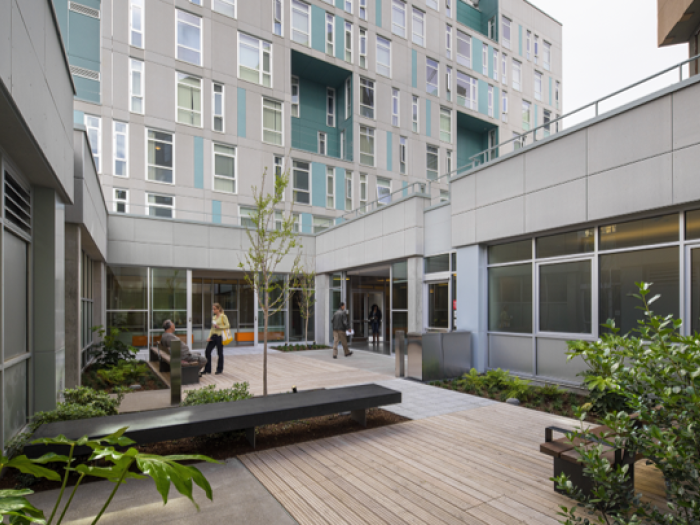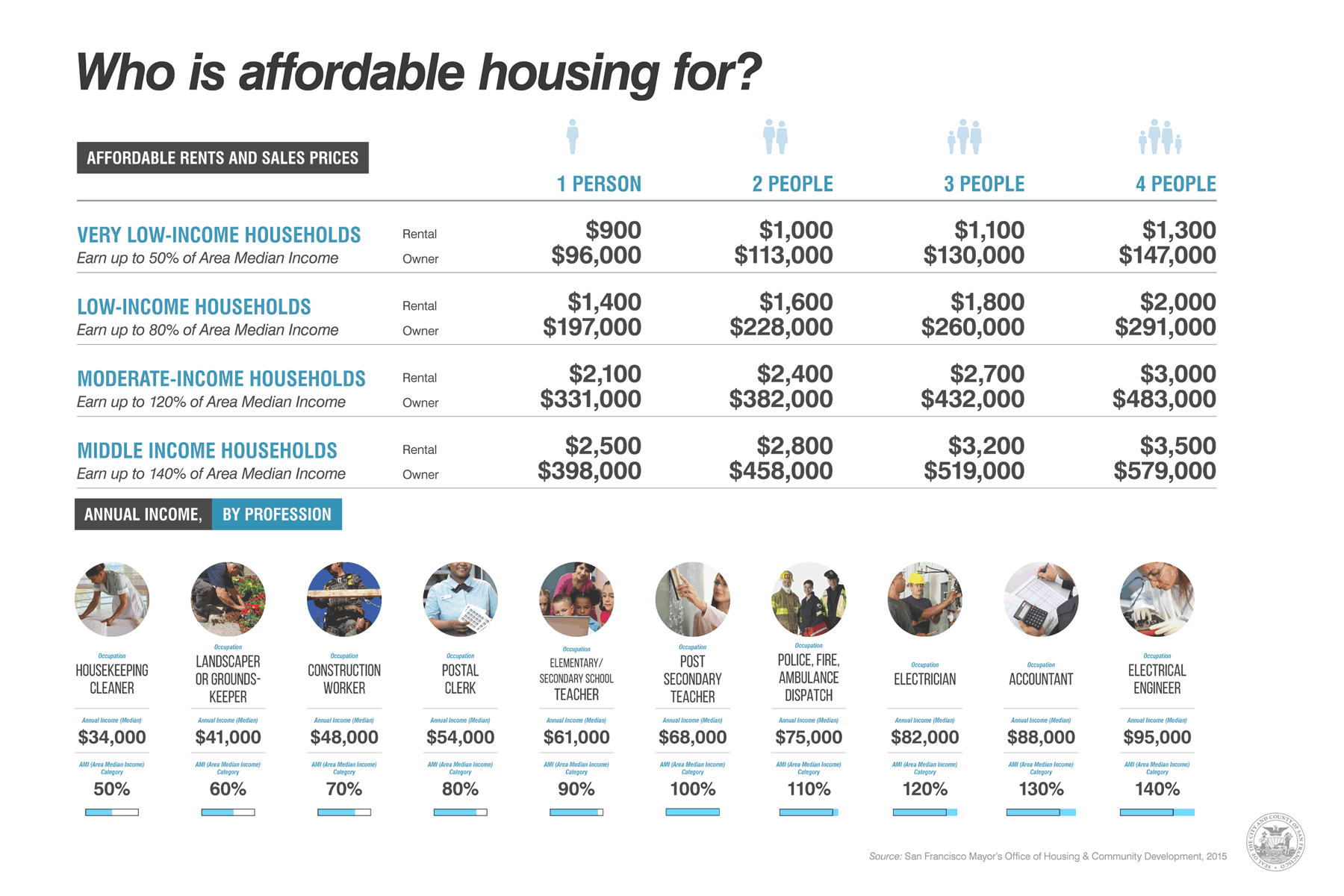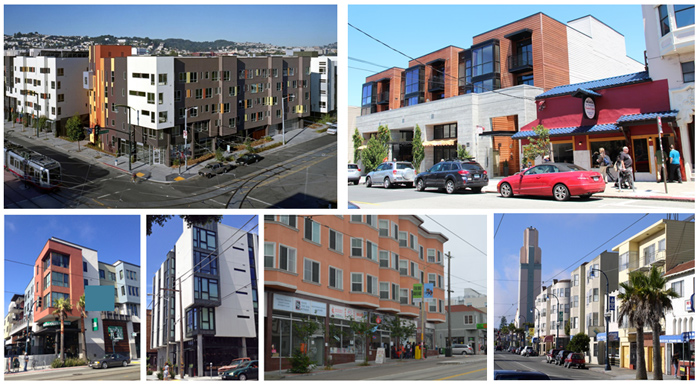
HOME-SF
The HOME-SF program is San Francisco’s local density bonus program. HOME-SF requires that 20 - 30% of the residential units be affordable, offers project sponsors priority processing, relief from density controls, and up to two extra stories of height. This program also offers a set menu of modifications project sponsors may choose from. The HOME-SF Program includes a number of location and project-specific eligibility criteria, outlined below, and is not currently available in zoning districts with no density limits.
How it Works
HOME-SF is an optional program for developers constructing mixed-income in certain areas of San Francisco. Under HOME-SF, 20 to 30 percent of the units in a new housing project must be affordable to low, middle and moderate-income families. To provide more family friendly housing, 40 percent of the total units in the building must be two bedrooms or larger (with an additional option of providing 50% of all bedrooms in the project in units with 2 or more bedrooms). In return, density bonuses and zoning modifications are provided, allowing project sponsors to accommodate additional affordable units.
In July 2018, the Board of Supervisors passed a pilot program creating the following tiers for HOME-SF:
|
|
Zoning modifications awarded |
Additional height awarded above existing height limit |
On-site affordability requirement |
|
Tier 1 |
Relief from density limit |
No additional height |
20-23 % |
|
Tier 2 |
1 story |
25% |
|
|
Tier 3 |
2 stories |
30% |
The Planning Department projects HOME-SF could result in up to 5,000 new affordable units over the next 20 years.
What is a Density Bonus?
A density bonus is an increase in the overall number of housing units that a developer may build on a site in exchange for including more affordable housing units in the project. Under HOME-SF, the maximum bonus for a project is an additional two stories and relief from density controls.
To be eligible for the HOME-SF program, each project:
- Must not demolish any residential units
- Will consist of new construction only and will not propose additions to existing buildings
- Must provide three or more dwelling units
- Must not demolish or significantly alter a historic resource
- Must not alter wind or create new shadow in a manner that substantially affects outdoor recreation facilities or other public areas as determined by the Environmental Review Officer
HOME-SF is not applicable in the RH-1 or RH-2 Zoning Districts, and is restricted in a number of other areas. See the application and information packet for detailed eligibility criteria. If your project does not qualify for HOME-SF, it may still qualify for the State Analyzed or State Individually Requested Density Bonus Programs.
HOME-SF projects require an entitlement called “HOME-SF Project Authorization” pursuant to Section 328 of the Planning Code. A HOME-SF Project Authorization entitlement requires a Planning Commission hearing within 120 days of submission of a complete HOME-SF application that is determined to meet the eligibility criteria. Public comment is welcomed at every Planning Commission hearing.
Staff will complete a design review for every project that chooses to participate in the HOME-SF program. This review will include the various dimensions, including height, setbacks, and other standard design considerations to ensure the completed project respects the surrounding context and keeps with the character of the neighborhood and commercial corridors.
For additional information on the application and the process, please view:
Small Businesses
HOME-SF requires project sponsors to provide at least 18 months advance notice of a proposed project to any existing commercial tenants on the site. HOME-SF also requires that any potentially displaced commercial tenants be connected with the Mayor's Office of Economic and Workforce Development (OEWD), which offers relocation assistance and support.
What are HOME-SF's affordability requirements?
Project sponsors that choose HOME-SF are required to offer 30% of units in their housing project at prices or rents affordable to low, middle and moderate-income families. Individuals and families can qualify for these units based on their income, measured in percent of Area Median Income (AMI). Currently, the affordable units are required to be affordable to the following income categories:
Rental Projects
|
|
Tier 1 (<25 units) |
Tier 1 (25+ units) |
Tier 2 |
Tier 3 |
|
55% AMI |
10% |
10% |
10% |
10% |
|
80% AMI |
5% |
8% |
8% |
10% |
|
110% AMI |
5% |
5% |
7% |
10% |
Ownership Projects
|
|
Tier 1 (<25 units) |
Tier 1 (25+ units) |
Tier 2 |
Tier 3 |
|
80% AMI |
10% |
10% |
10% |
10% |
|
105% AMI |
5% |
8% |
8% |
10% |
|
130% AMI |
5% |
5% |
7% |
10% |
What is Area Median Income (AMI)?
Find the latest on AMI in San Francisco.
Half of all households in San Francisco earn less than this AMI and the other half of households earn more. AMI is set each year by the US Department of Housing and Urban Development (HUD) and is based on household size and the income households earn in the area. The City uses these annually published income limits to inform its various housing programs.
The total of all salaries earned by all people living in the same home equals the household's total annual income.
See the Mayor's Office of Housing and Community Development for more information about who qualifies for affordable housing.
Who qualifies for affordable units in HOME-SF projects?
Eligibility for affordable units is determined by a household's a) size (number of people in the household) and b) income (amount of income earned by all members of the household).
Below is a sample table of income ranges that would qualify households of various sizes for affordable units in HOME-SF projects. Please see the Mayor's Office of Housing and Community Development for more detailed information on the BMR rental and ownership programs.
| Household Size | Income range to qualify for rental unit |
Income range to qualify for ownership unit |
| 1 | $45,600 - $91,200 | $66,300 - $107,750 |
| 2 | $52,100 - $104,150 | $75,750 - $123,100 |
| 3 | $58,600 - $117,200 | $85,250 - $138,500 |
| 4 | $65,100 - $130,250 | $94,700 - $153,900 |
Note: Above figures are approximate, based on data available as of September 2018. Income qualification will be determined by MOHCD.
How much will the affordable units in HOME-SF projects be sold or rented for?
Units will be priced according to size (number of bedrooms) and the income level of the household that will be occupying the unit.
Below is a sample table of potential rents and sales prices for affordable units in HOME-SF projects. Please see the Mayor's Office of Housing and Community Development for more detailed information on the BMR rental and ownership programs.
| Unit Size | Range of rents | Range of prices |
| Studio | $1,090 - $2,230 | $220,900 - $429,700 |
| 1 BR | $1,360 - $2,540 | $264,400 - $503,000 |
| 2 BR | $1,510 - $2,850 | $299,100 - $567,500 |
| 3 BR | $1,670 - $3,150 | $340,700 - $639,000 |
Note: Above figures are approximate, based on data available as of September 2018. Rents and sales prices will be determined by MOHCD.
Links To Relevant State Legislation and San Francisco Planning Code Sections
- State Density Bonus Law
- HOME-SF (Section 206.3)
- Analyzed State Density Bonus Program (Section 206.5)
- Individually Requested State Density Bonus Program (Section 206.6)
Case reports, Ordinance, Motions, Resolutions and Public Hearings by publication date – for those following closely.
| Date | Legislation/Resolutions/Motions and Staff Case Reports |
Presentation Materials and Video |
|---|---|---|
| February 14, 2017 | Draft HOME-SF Program Legislation | N/A |
| March 13, 2017 | March 13th Draft HOME-SF Program Legislation Board of Supervisors Land Use and Transportation Committee Amendments made:
|
Link to SFGTV video on demand |
| May 8, 2017 | May 8th Draft HOME-SF Program Legislation Board of Supervisors Land Use and Transportation Committee Amendments made:
|
Link to SFGTV video on demand |
| May 16, 2017 | May 16th Draft HOME-SF Program Legislation Full Board of Supervisors Amendments made:
|
Link to SFGTV video on demand |
| May 23, 2017 | May 23rd HOME-SF Program Legislation Full Board of Supervisors Amendments made:
|
Link to SFGTV video on demand |
| June 6, 2017 | Final Adopted HOME-SF Legislation (large file size) Full Board of Supervisors The legislation was passed on second read with a unanimous vote of 110. |
Link to SFGTV video on demand |
| May 1, 2018 | HOME-SF 2.0 Legislation Supervisors Tang and Safai introduce legislation to amend HOME-SF as follows:
|
|
| June 28, 2018 | Planning Department Case Report The Planning Department recommended the following amendments:
|
Link to SFGTV video on demand |
| July 9, 2018 |
July 9th HOME-SF 2.0 Legislation with amendments The legislation was amended to incorporate Planning Department recommendations 1, 2 and 4 above. The legislation as amended was sent to the full Board of Supervisors with a positive recommendation, and with the following amendments:
|
Link to SFGTV video on demand |
| July 17, 2018 | July 17th HOME-SF 2.0 Legislation with amendments The legislation was amended to include a use it or lose it provision, requiring HOME-SF projects to receive a site or building permit within 36 months of receiving entitlements. The legislation as amended was passed on first reading. |
Link to SFGTV video on demand |
| July 31, 2018 | Final HOME-SF 2.0 Legislation The legislation was passed on second reading. |
Link to SFGTV video on demand |
| February 16, 2023 |
Planning Department Case Report The Planning Commission recommended the following amendments for Board File 221021:
|
Link to SFGTV video on demand |
| April 24, 2023 |
April 24th Legislation with amendments Board File 221021 was amended to include the Planning Commission recommendations 1 and 2 from above, along with the following amendments:
|
Link to SFGTV video on demand |
| May 9, 2023 |
Full Board of Supervisors Board Files 221021 and 221105 were passed on first reading with a vote of 10-1. |
Link to SFGTV video on demand |
| May 16, 2023 |
Full Board of Supervisors Board Files 221021 and 221105 were passed on first reading with a vote of 10-1. |
Link to SFGTV video on demand |
Who will qualify to live in the affordable housing produced by this program?
HOME-SF will create homes for very low, low, moderate, and middle-income households. The chart above illustrates how these terms are defined and what professions tend to fall into each category.
Area = A particular geographical area, e.g., San Francisco
Median = Middle point: half of the households earn below the median while the other half earn above
Income = Total income of the entire household
- Very-low income households: Earn up to 55 percent of the Area Median Income in San Francisco
- Low-income households: Earn up to 80 percent of the Area Median Income in San Francisco
- Moderate-income households: Earn up to 120 percent of the Area Median Income in San Francisco
- Middle-income households: Earn up to 140 percent of the Area Median Income in San Francisco
Half of the households in San Francisco earn below the AMI while the other half of households earn above the City's AMI. AMI is set each year by HUD and is based on household size and the income households earn in the area. The City uses these annually published income limits to inform its various housing programs.
The total of all salaries earned by all people living in the same home equals the household's total annual income. Based on the 2010 American Community Survey (also known as the U.S. Census), the typical San Francisco household has approximately 2.4 people.
See the Mayor's Office of Housing and Community Development for more information about who qualifies for affordable housing.

What will HOME-SF developments look like?
In keeping with the character of the neighborhood areas and commercial corridors, HOME-SF residential developments will be required to place a strong emphasis on ground floor retail (also known as mixed-use buildings). In addition, the HOME-SF team will develop specific design guidelines that require proposed projects to include elements such as:
- Commercial spaces with active ground floor uses
- Transparent and operable windows, awnings, and informational displays
- Attention to design detail, including variation in material use
Click here for an overview of the existing design review process.
The following photos are examples of mixed use-buildings.

What is the design review process for HOME-SF developments?
Staff will complete a design review for all projects that elect to participate in HOME-SF. This review will include the various dimensions of proposed projects, including height, relevant setbacks, and other standard design considerations. Projects will be required to apply design solutions, such as:
- Planting living walls or vines on property line walls
- Window detailing
- Varying the building façade materials and depth from the sidewalk
- Providing an active ground floor
These design elements, among others, will ensure developments blend with adjoining buildings to ensure consistency with neighborhood character.
Will HOME-SF developments need to pay development impact fees?
Yes. The City imposes impact fees on development projects in order to mitigate the impacts caused by new development on public services, infrastructure, and facilities. For example, new residential and commercial projects pay impact fees to offset burdens placed on transit systems and sidewalks. Some impact fees apply to various types of development projects throughout the City, while others apply only in certain neighborhoods.
Learn more about the City's Development Impact Fees.
What other City programs encourage affordable housing?
San Francisco has several other programs designed to create new affordable housing, protect the existing housing supply, and encourage higher levels of affordable housing through development incentives, such as:
Other programs include:
See the Mayor's Office of Housing and Community Development, the Office of Community Investment and Infrastructure, and the San Francisco Housing Authority for more information and a complete listing of all programs.
